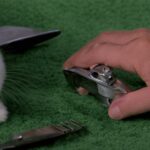Trimming your cat’s nails can be a daunting task, but it is important for their health and to protect your furniture. This article will provide step-by-step guidance on how to cut cat nails, along with answers to common questions about the process.
Key Takeaways:
- Regular nail trimming promotes cat health and prevents issues such as overgrown nails and related injuries.
- Proper technique and positive reinforcement can help make the nail trimming process stress-free for both you and your cat.
- Choosing the right tools, such as scissors-style nail clippers, can make the process easier and more effective.
- If you accidentally cut the quick and cause bleeding, stay calm and apply a small amount of cornstarch to help stop the bleeding.
- If you are not comfortable or experienced with nail trimming, or if your cat becomes highly fractious during the process, it may be best to seek professional assistance.
Is Trimming Cat Nails Necessary?
Regular nail trimming is an essential part of cat care and grooming. While cats naturally groom themselves, their nails can become overgrown, leading to discomfort and potential health issues. Additionally, cats use their claws for various activities, including scratching to mark territory and stretch their muscles. Trimming their nails helps prevent damage to furniture and surfaces while promoting healthy scratching behavior.
When a cat’s nails are left untrimmed, they can curl and grow into the paw pads, causing pain, inflammation, and infection. Trimmed nails also reduce the risk of accidental scratches to both humans and other pets in the household. By incorporating nail trimming into your cat’s grooming routine, you can contribute to their overall health and well-being.
Regular nail trimming is an essential part of cat care and grooming.
Trimming your cat’s nails regularly provides an opportunity to check for any abnormalities, such as ingrown nails or infections. It is recommended to trim your cat’s nails about once a month or as needed. The frequency may vary depending on your cat’s lifestyle and individual nail growth rate. If you’re unsure about when to trim their nails, consult your veterinarian for guidance.
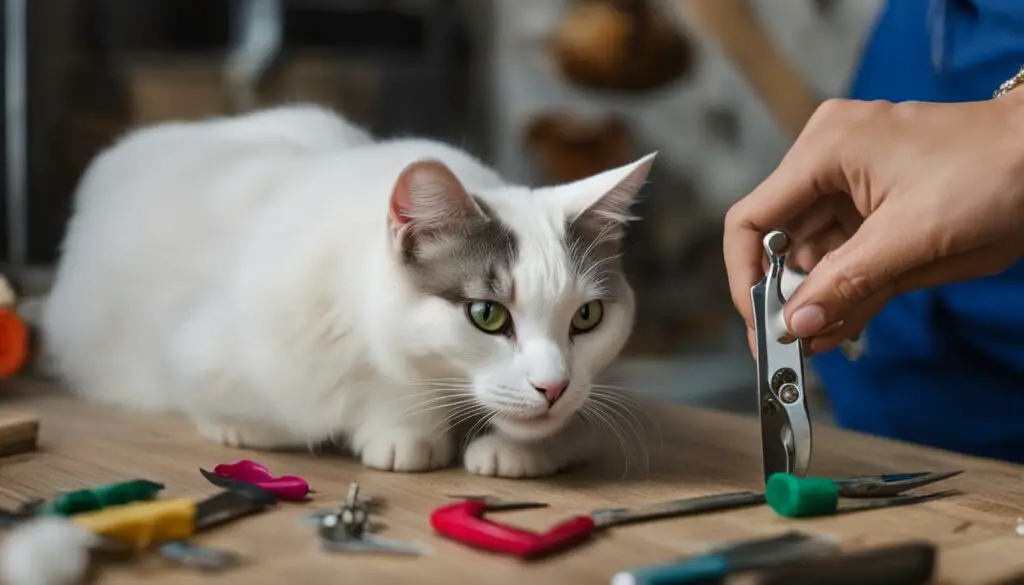
Is Trimming Cat Nails Necessary?
Trimming your cat’s nails is an important aspect of cat health and care. Not only does it prevent discomfort and potential injuries, but it also promotes a positive environment within your home. By ensuring your cat has well-maintained nails, you can protect your furniture while encouraging healthy scratching behaviors.
When To Trim Your Cat’s Nails
Proper nail care is essential for your feline friend’s health and well-being. While cats often take care of their own nails through scratching and biting, it is important for owners to check their cat’s nails regularly and trim them if necessary.
So, how do you know when it’s time to trim your cat’s nails? A good rule of thumb is to check their nails about once a month. If the nails appear short and stubby, it means your cat has been diligently keeping them trimmed. However, if the nails have a circular curve like a hook, it is a clear indication that it’s time for a trim.
Trimming your cat’s nails on a regular basis not only helps prevent discomfort and pain caused by overgrown nails, but it also promotes healthy scratching behaviors. By keeping their nails at a proper length, you can protect your furniture and surfaces from potential damage.
When To Trim Your Cat’s Nails:
- Check your cat’s nails once a month.
- If the nails appear short and stubby, your cat is keeping them trimmed.
- If the nails have a circular curve like a hook, it’s time to trim them.
By following these guidelines and trimming your cat’s nails when necessary, you can ensure their overall health and well-being while also maintaining a scratch-free home.
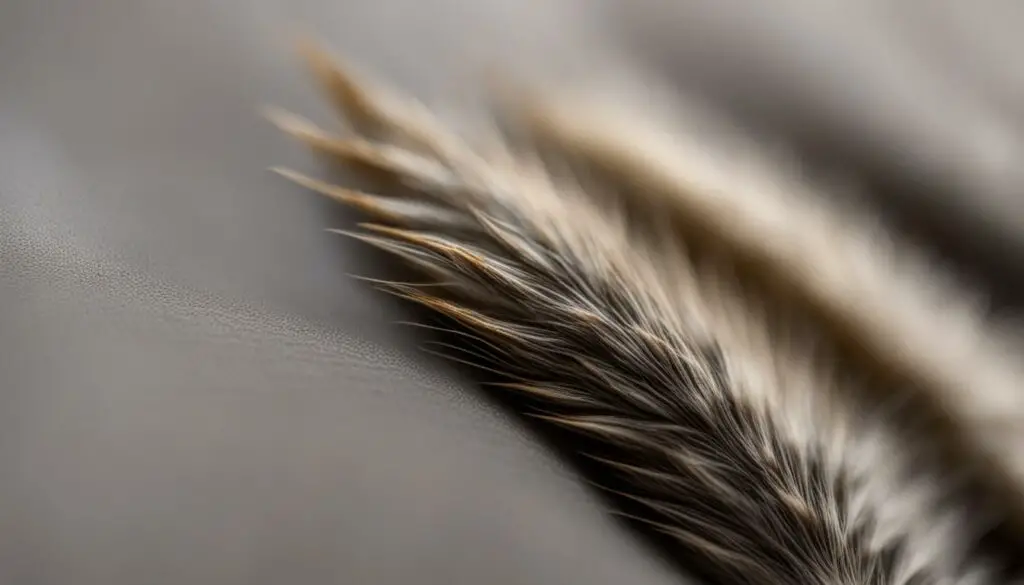
Table: Signs it’s time to trim your cat’s nails
| Signs | Time to Trim |
|---|---|
| Nails appear short and stubby | Cat is keeping them trimmed |
| Nails have a circular curve like a hook | It’s time to trim |
Tools for Trimming Cat Nails
When it comes to trimming your cat’s nails, having the right tools can make all the difference. The recommended tools for this task are scissors-style nail clippers specifically designed for cats. These clippers provide a clean and precise cut, making the process easier and safer for both you and your feline friend.
Unlike guillotine-style clippers, which can crush and split the nail, scissors-style clippers have a straight cutting edge that ensures a smooth cut. This helps prevent any discomfort or pain for your cat during the trimming process. Additionally, the grip and handle of these clippers are designed to provide better control and stability, reducing the risk of accidental injuries.
It is important to note that using specialized cat nail clippers is essential. Human nail clippers may not have the right design or sharpness to cut through a cat’s thicker nails, which can lead to uneven cuts or nail damage. Using the correct tools ensures a more efficient and stress-free experience for both you and your cat.
“Investing in a pair of high-quality scissor-style nail clippers for cats is a wise decision. These clippers are specifically designed with the unique anatomy of cat nails in mind, making the trimming process safer and more comfortable for your furry companion.” – Dr. Samantha Carter, DVM
Remember to regularly inspect and clean your cat’s nail clippers after each use to maintain hygiene and prevent the spread of any potential infections. Keeping your tools clean and in good condition will ensure that they remain effective and functional for future nail trimming sessions.
| Nail Clippers | Features |
|---|---|
| Scissors-style Nail Clippers | – Straight cutting edge for a clean cut – Designed for cats’ nail anatomy – Improved control and stability – Reduced risk of injury |
| Guillotine-style Nail Clippers | – Rounded cutting edge that can split the nail – May cause discomfort or pain for cats – Less control and stability – Higher risk of injury |
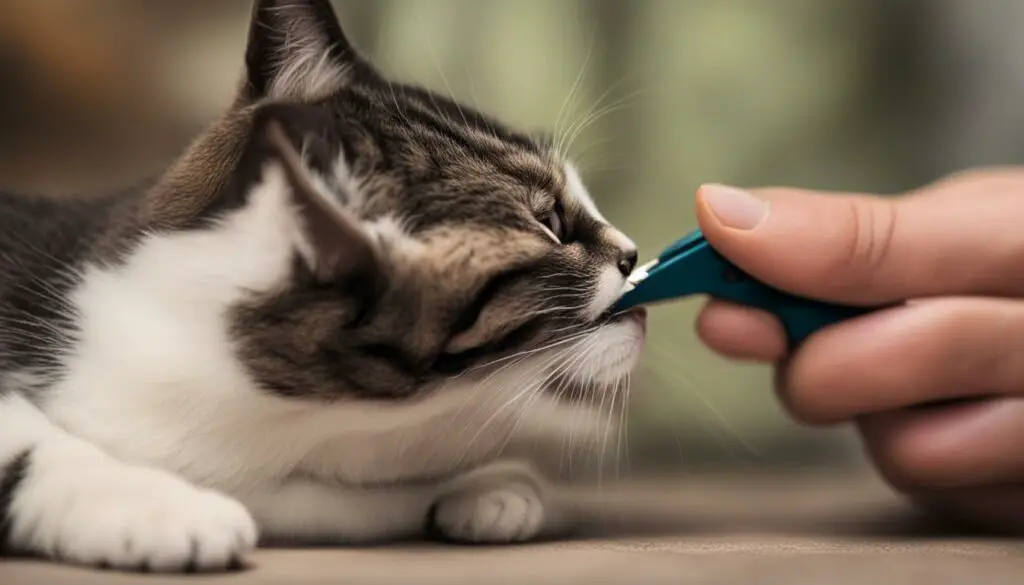
By using the right tools and following proper techniques, you can make the nail trimming experience a positive one for both you and your cat. Remember to approach the process with patience, be gentle, and provide rewards and positive reinforcement throughout. Keeping your cat’s nails trimmed not only promotes their health and well-being but also helps prevent any unwanted scratching or furniture damage. So, invest in a pair of scissors-style nail clippers and make nail trimming a regular part of your cat’s grooming routine.
How To Trim Cat Nails – Step-by-Step Guide
Trimming your cat’s nails can be a simple and stress-free process when done correctly. Follow these step-by-step instructions to ensure a safe and positive experience for both you and your furry friend.
Step 1: Securely hold your cat
Find a comfortable position for both you and your cat. Some options include cradling them on your lap or using a towel wrap. Ensure that your cat feels secure and relaxed before proceeding.
Step 2: Use positive reinforcement
Before starting the nail trimming process, establish a positive association by providing treats or praise. This will help your cat associate the experience with something pleasant.
Step 3: Expose and make the cut
Gently press on the paw pads to expose the nails. Use cat nail clippers to make a clean cut, taking care to avoid the quick, which is the pink part of the nail that contains blood vessels and nerves. Aim to trim just the sharp tip of the nail.
Step 4: Trim slowly and reward
Trim each nail slowly and calmly, giving your cat a treat after each successful trim. Be patient and only trim as much as your cat will allow. If your cat becomes stressed or agitated, take a break and try again later.
| Step | Instructions |
|---|---|
| 1 | Securely hold your cat in a comfortable position. |
| 2 | Use positive reinforcement to reward good behavior. |
| 3 | Press on the paw pads to expose the nails and make the cut. |
| 4 | Trim the nail slowly and give a treat at the same time. Only trim as much as the cat will allow. Repeat for each nail. |
Remember to remain calm and patient throughout the process. If you encounter any difficulty or if your cat becomes highly stressed, it may be best to seek professional assistance from a veterinarian or a professional groomer.
With regular nail trimming and positive reinforcement, you can help keep your cat’s nails in optimal condition and maintain their overall health and well-being.
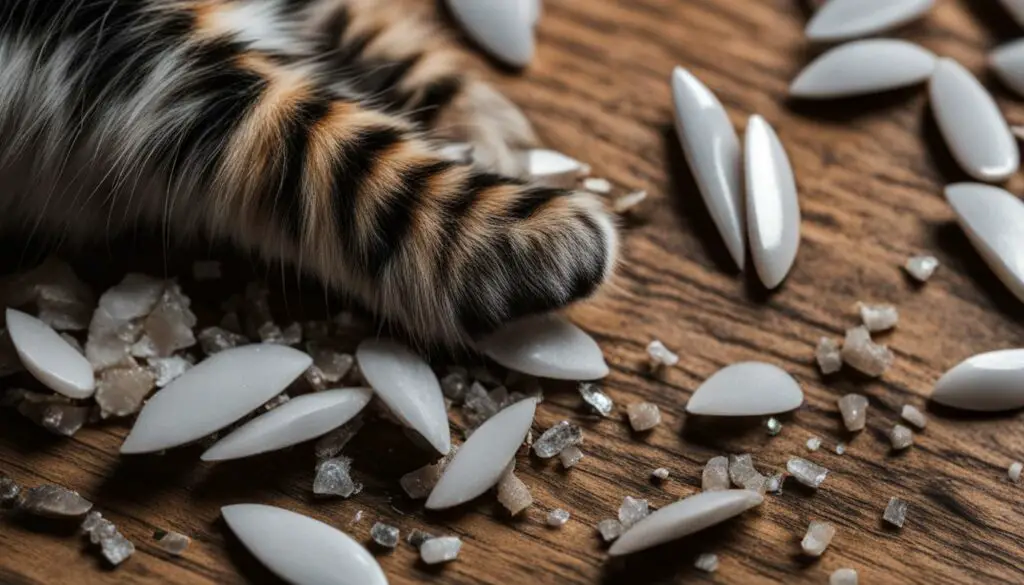
How Much to Trim
When it comes to trimming your cat’s nails, it’s important to know how much to trim to ensure their comfort and safety. The key is to only trim the white part of the nail, avoiding the pink part known as the quick. Cutting into the quick can cause pain and bleeding, so it’s better to err on the side of caution and take too little off than too much.
Table: Nail Anatomy
| Nail Part | Description |
|---|---|
| White Part | The part of the nail that extends beyond the quick. This is the safe area to trim. |
| Pink Part (Quick) | The sensitive part of the nail that contains blood vessels and nerves. Cutting into this area can cause pain and bleeding. |
When trimming your cat’s nails, make sure to use a specialized cat nail clipper and approach the task with care. If you’re unsure or uncomfortable trimming your cat’s nails yourself, it’s always best to seek professional help from a veterinarian or a professional groomer.
Dealing with Accidental Cuts
Accidents can happen during the nail trimming process, and it’s possible to accidentally cut the quick of your cat’s nail, causing bleeding. While it may be alarming, it’s important to stay calm and take immediate action to address the situation.
If you find that you’ve accidentally cut the quick, the first step is to distract your cat from the incident. You can try offering treats or engaging them with toys to redirect their attention. This will help keep them calm and prevent further stress or agitation.
To stop the bleeding, you can apply a small amount of cornstarch directly to the wound. Cornstarch helps to clot the blood and acts as a natural coagulant. Gently press the cornstarch onto the cut area, being careful not to apply too much pressure. If bleeding continues or if your cat appears to be in distress, it is best to seek veterinary assistance immediately.
| Steps to Deal with Accidental Cuts | Materials Needed |
|---|---|
| 1. Stay calm and try to distract your cat | – Treats – Toys |
| 2. Apply a small amount of cornstarch to the bleeding area | – Cornstarch |
| 3. Seek veterinary assistance if bleeding persists or if your cat is in distress | – Contact information of your veterinarian |
Remember, accidents can happen even with the utmost care and caution. It’s essential to be prepared and know-how to handle these situations calmly and effectively to ensure the well-being of your cat.
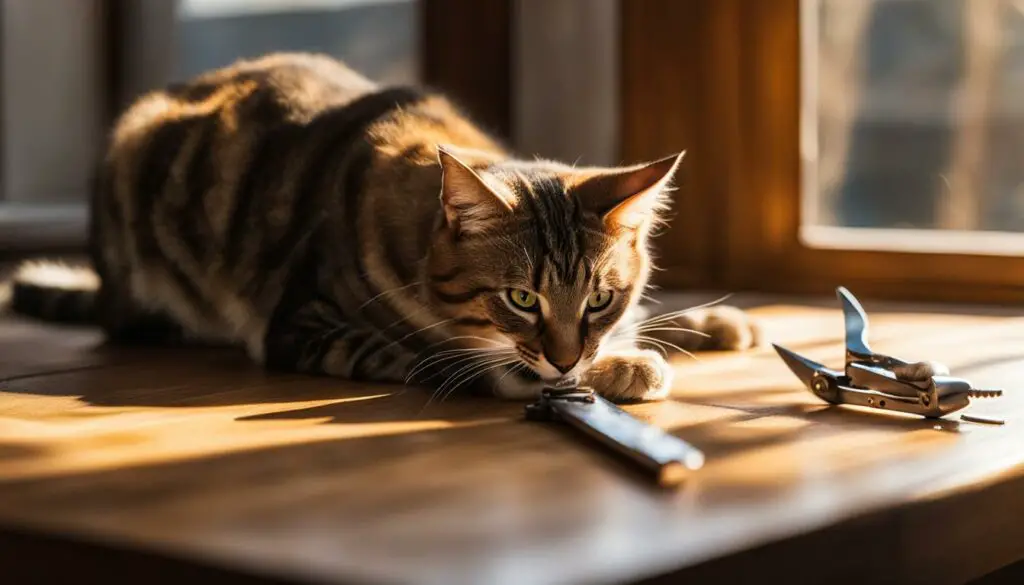
When to Seek Professional Help
While many cat owners trim their cat’s nails themselves, there are situations where professional help may be necessary. It is important to prioritize the safety and well-being of your cat, especially if you are not comfortable or experienced with nail trimming. Seek professional assistance if:
- Your cat has hidden or curling nails: Some cats may have nails that are difficult to see or trim due to their coloring or curling shape. A professional groomer or veterinarian will have the expertise to handle these types of nails effectively.
- Your cat becomes highly fractious during the process: Some cats become extremely anxious or aggressive when it comes to nail trimming. If you are unable to safely handle your cat or if the process becomes too stressful for both of you, professional assistance can help ensure the task is completed without causing harm or distress.
- You are unsure about the proper nail clipping technique: If you are unsure about how to trim your cat’s nails correctly and safely, it is best to seek guidance from a professional. They can demonstrate the proper technique and provide valuable tips to make the process easier for both you and your cat.
Remember, seeking professional help for nail trimming is not a sign of failure. It simply shows that you prioritize your cat’s health and well-being above all else. By entrusting the task to an experienced professional, you can ensure that your cat’s nails are properly trimmed and prevent any potential injuries or mishaps.
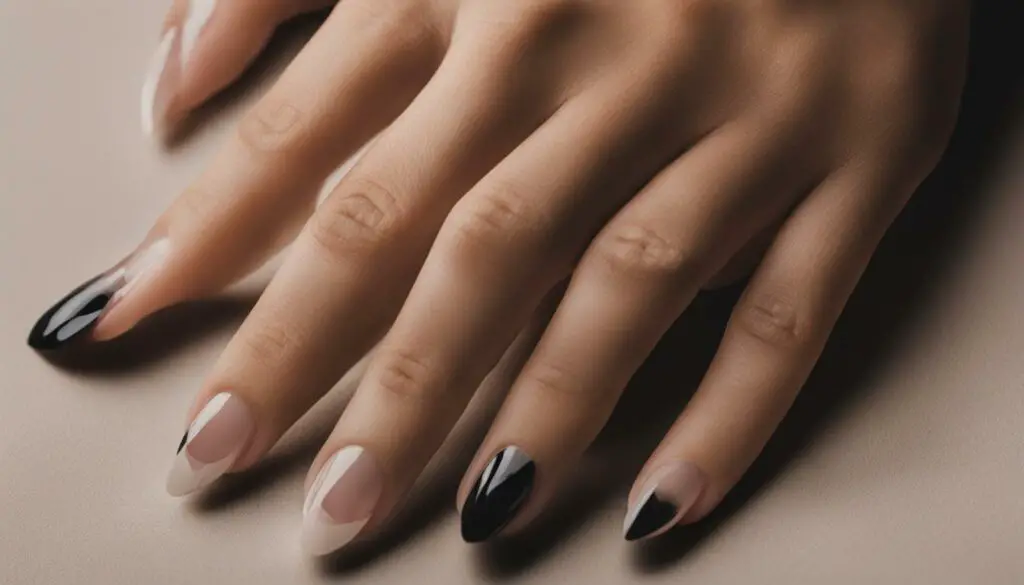
Benefits of Regular Nail Trimming
Regular nail trimming is an essential part of maintaining your cat’s health and overall well-being. Not only does it prevent issues like overgrown nails and related injuries, but it also plays a vital role in promoting positive behaviors and ensuring the longevity of your furniture and surfaces.
Promotes Cat Health
- Regular nail trimming helps prevent nail-related health issues in cats. Overgrown nails can curl and grow into the paw pads, causing pain, discomfort, and potential infection. By keeping your cat’s nails at an appropriate length, you can avoid these complications and ensure their comfort.
- Nail care also prevents accidental scratches and cuts on your cat’s skin, reducing the risk of infection. Trimming the nails eliminates sharp edges that could potentially harm your cat or other household members.
Protects Furniture and Surfaces
Cats have a natural instinct to scratch, which is important for maintaining the health of their claws. However, when their nails are too long or sharp, their scratching behavior can cause damage to your furniture, carpets, and other surfaces in your home.
- Regular nail trimming helps prevent this damage by keeping your cat’s nails at a manageable length. Blunt nails are less likely to cause scratches and tears, ensuring the longevity of your furniture and preserving the aesthetic appeal of your living spaces.
- By providing your cat with appropriate scratching alternatives, such as scratching posts and boards, you can further redirect their scratching behavior away from your furniture.
Overall, regular nail trimming is a small but essential aspect of cat care. By maintaining the health of your cat’s nails and promoting positive behaviors, you can ensure their comfort, protect your furniture, and strengthen the bond between you and your feline companion.

Understanding Your Cat’s Claws
When it comes to understanding your cat’s claws, there are a few key points to keep in mind. Firstly, a cat’s claws have a unique anatomy, with retractable claws that can be extended or retracted at will. This ability allows cats to keep their claws sharp for hunting and self-defense while also protecting them from wear and tear in everyday activities.
The claw itself is composed of a hard outer shell called the sheath, which protects the softer inner part of the claw known as the quick. The quick contains blood vessels and nerves, and trimming into this area can cause pain and bleeding. It is important to be aware of the quick’s location when trimming your cat’s claws to ensure a safe and comfortable experience for both you and your feline friend.
Cat behavior is also closely linked to their claws. Scratching is a natural behavior for cats, serving various purposes such as stretching, marking territory, and keeping their claws in good condition. By understanding your cat’s natural instinct to scratch, you can provide appropriate alternatives such as scratching posts or boards to redirect their attention away from your furniture and belongings.
To summarize, understanding your cat’s claws involves recognizing their retractable nature, knowing the difference between the sheath and the quick, and acknowledging their role in cat behavior. By having this knowledge, you can approach claw trimming and scratching behavior in a way that promotes your cat’s well-being and strengthens your bond with them.
| Key Points |
|---|
| Cat claws are retractable, allowing cats to keep them sharp and safe. |
| The claw consists of a sheath and a quick, with the quick containing blood vessels and nerves. |
| Cat behavior, such as scratching, is closely tied to their claws. |
| Understanding your cat’s claws enables you to approach claw trimming and scratching behavior in a way that benefits both you and your cat. |
“A cat’s retractable claws are not just a feature of their anatomy, but a fascinating aspect of their behavior and self-care.” – Emily, Cat Enthusiast
Preparing for Claw Trimming
Proper preparation is essential to ensure a successful and stress-free claw trimming session for your cat. By following these tips, you can create a comfortable and safe environment for both you and your furry friend.
Grooming Routine
Establishing a regular grooming routine can help your cat become more accustomed to having their claws trimmed. Start by gently touching and handling their paws on a daily basis, gradually increasing the amount of time each day. This will help desensitize them to the sensation and make the process easier.
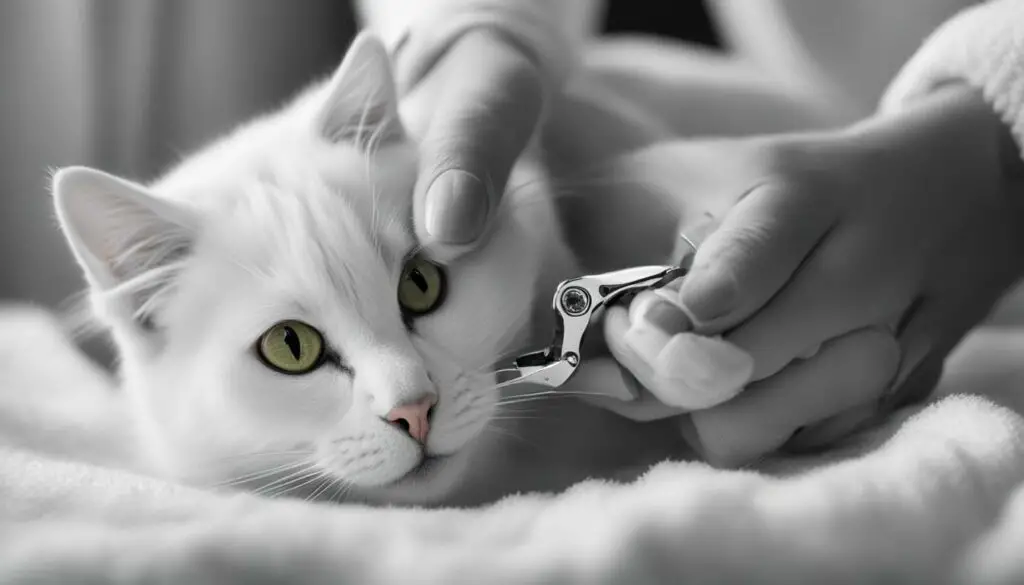
Preparation Tips
Choose a well-lit area for the nail trimming session, preferably near a window or with ample artificial lighting. This will allow you to see the claws clearly and avoid accidents. Additionally, it’s important to have all the necessary tools within reach, such as cat nail clippers and styptic powder to stop bleeding in case of accidental cuts.
Styptic Powder
Styptic powder is a valuable tool to have on hand during claw trimming. If you accidentally cut the quick and cause bleeding, applying a small amount of styptic powder to the affected area can help stop the bleeding quickly. It’s best to have this powder ready before starting the nail trimming process.
| Preparation Tips for Claw Trimming | Benefits |
|---|---|
| Choose a well-lit area | Allows for better visibility and accuracy |
| Gather all necessary tools | Ensures a smooth and uninterrupted process |
| Have styptic powder on hand | Quickly stops bleeding in case of accidental cuts |
Remember, patience and a calm demeanor are key when preparing for claw trimming. Cats can sense your energy, so maintaining a relaxed and positive attitude will help create a more pleasant experience for both of you.
Handling Your Cat During Trimming
Handling your cat properly during the nail trimming process is crucial to ensure their comfort and safety. By following these tips, you can create a secure and stress-free environment for both you and your feline friend.
Selecting a Secure Position
Choosing the right position to trim your cat’s nails is essential. One option is the football hold, where you cradle your cat against your body, supporting their chest and hindquarters. This position provides stability and prevents excessive movement. Another option is placing your cat on a stable surface, such as a table or countertop, using a non-slip mat for added security.
Enlisting an Assistant
If you find it challenging to handle your cat alone during nail trimming, enlisting the help of an assistant can make the process smoother. The assistant can gently hold your cat’s paw, ensuring it remains still while you trim the nails. This cooperative effort can reduce stress and enhance safety. Remember to reward your cat with treats and praise for their patience and cooperation.
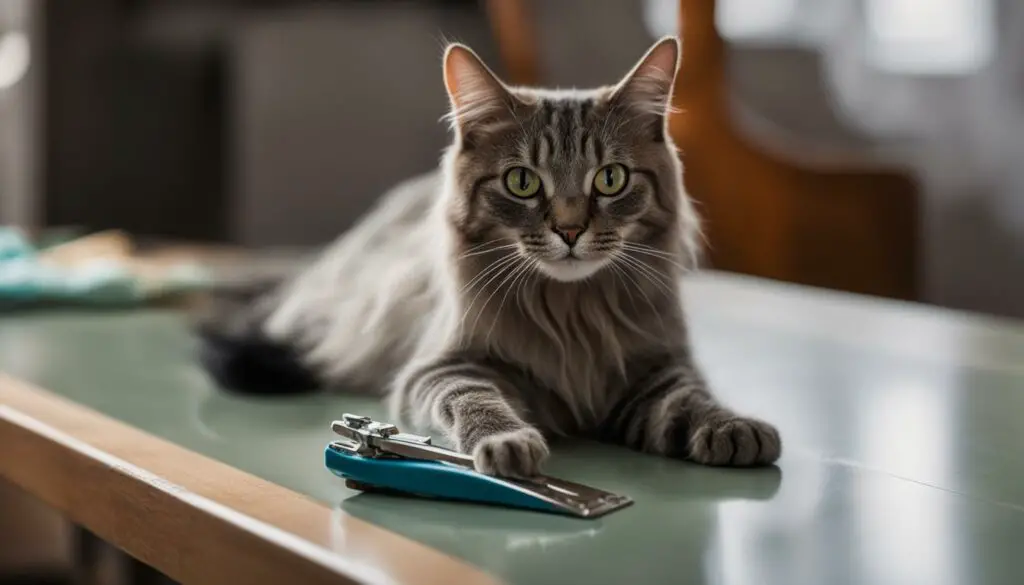
Ensuring a Calm Environment
Cats are sensitive to their surroundings, so it’s important to create a calm and quiet environment during nail trimming sessions. Find a location where your cat feels comfortable and secure, away from distractions. Minimize noise and disruptions, such as other pets or loud appliances, to help your cat stay calm and focused.
Using Positive Reinforcement
Positive reinforcement plays a key role in handling your cat during nail trimming. Reward your cat with treats, gentle strokes, and soothing words throughout the process. This positive association can help your cat associate nail trimming with a pleasant experience, making future sessions easier.
By following these handling tips, you can ensure that both you and your cat have a positive and successful nail trimming experience.
Step-by-Step Guide to Trimming Cat Claws
Trimming your cat’s claws is an essential part of their grooming routine. Follow this step-by-step guide to ensure a successful and stress-free nail trimming session for both you and your feline friend.
1. Choose a secure and comfortable position
Find a quiet area where you and your cat can relax. Choose a position that allows you to easily access your cat’s paws and claws. You can cradle your cat on your lap, place them on a stable surface, or gently wrap them in a towel for added security.
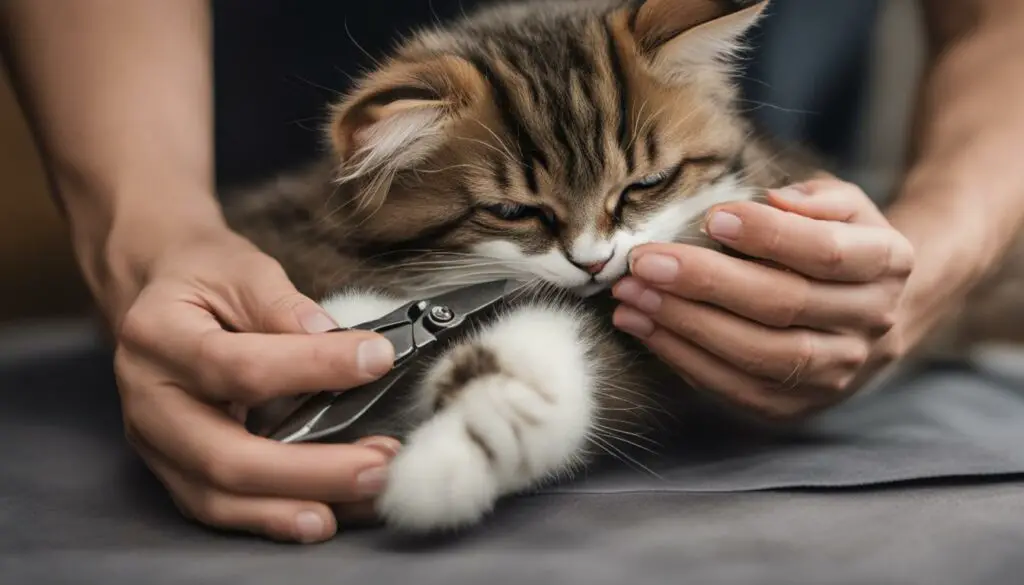
2. Gently extend the claws and locate the quick
Gently press your cat’s paw pads to extend the claws. Take your time and be patient. Look for the translucent area known as the quick, which supplies blood to the nail. Be careful not to cut into the quick to avoid causing pain or bleeding.
3. Trim the claws, being careful not to cut into the quick
Using specialized cat nail clippers, make a clean and quick cut at a slight angle, taking off the sharp tip of the claw. Remember to trim only the white part of the claw, avoiding the pink area. If your cat’s claws are dark, shine a flashlight behind them to help locate the quick.
4. Take breaks and reward your cat for cooperation
Take breaks between trimming each claw if needed. This will allow your cat to relax and regroup. Offer treats or praise to reward your cat for their cooperation throughout the process. By creating a positive association with nail trimming, your cat will be more likely to cooperate in future sessions.
Remember, patience and a calm demeanor are key when trimming your cat’s claws. If you’re unsure or uncomfortable with the process, consider seeking professional assistance from a veterinarian or a professional groomer. With regular nail trimming, you’ll help keep your cat’s claws at a comfortable length, promote healthy scratching behaviors, and maintain their overall well-being.
Conclusion
Trimming your cat’s nails is an important aspect of cat care and grooming. With proper technique, preparation, and patience, it can be a successful and stress-free process. Regular nail trimming promotes cat health, prevents furniture damage, and fosters a positive relationship between cats and their owners.
By maintaining your cat’s nails at the appropriate length, you can prevent discomfort and potential injuries caused by overgrown nails. Additionally, regular nail trimming helps protect your furniture and surfaces from scratching damage, ensuring a harmonious living environment for both you and your feline friend.
Remember to approach nail trimming with a calm and gentle demeanor, using positive reinforcement to reward your cat’s cooperation. With practice and consistency, you can establish a routine that makes nail trimming a positive experience for both you and your cat.
FAQ
Is trimming a cat’s nails necessary?
Yes, regular nail trimming is necessary for a cat’s health and well-being. It helps prevent overgrown nails, discomfort, and furniture damage.
When should I trim my cat’s nails?
You should check your cat’s nails about once a month. If they appear short and stubby, your cat has been keeping up with them. If they have a circular curve like a hook, it’s time to trim.
What tools do I need for trimming cat nails?
It’s recommended to use scissors-style nail clippers specifically made for cats. They provide a clean cut and are easier to use compared to guillotine-style clippers.
How do I trim my cat’s nails?
Here are the steps: securely hold your cat in a comfortable position, press on the paw pads to expose the nails, trim the nail slowly, and give a treat at the same time. Repeat for each nail.
How much should I trim?
Only trim the white part of the nail. Avoid cutting into the pink part (the quick), as it can cause pain and bleeding.
What should I do if I accidentally cut the quick and cause bleeding?
Stay calm, distract your cat with treats or toys, and apply a small amount of cornstarch to stop the bleeding. If it persists or the cat is in distress, seek veterinary assistance.
When should I seek professional help for nail trimming?
It’s best to seek professional help if you’re not comfortable or experienced with nail trimming, if your cat has hidden or curling nails, or if your cat becomes highly fractious during the process.
What are the benefits of regular nail trimming?
Regular nail trimming helps maintain cat health, prevents overgrown nails and related injuries, and protects furniture and surfaces from scratching damage.
How do I handle my cat during nail trimming?
Securely hold your cat in a comfortable position, such as the football hold or on a stable surface. Consider enlisting the help of an assistant.
What is the best way to prepare for claw trimming?
Choose a comfortable and well-lit location, have styptic powder on hand in case of bleeding, and familiarize yourself with the process before getting started.
What is the step-by-step process for trimming cat claws?
Gently extend the claws, locate the quick, trim the claws, being careful not to cut into the quick, take breaks if needed, and reward your cat with treats or praise for cooperation.



